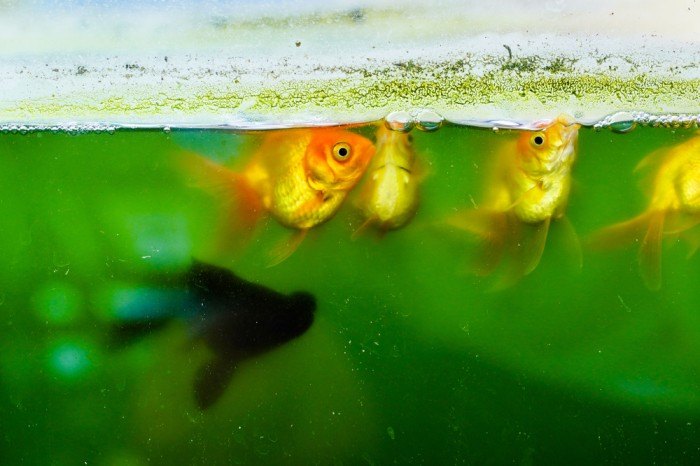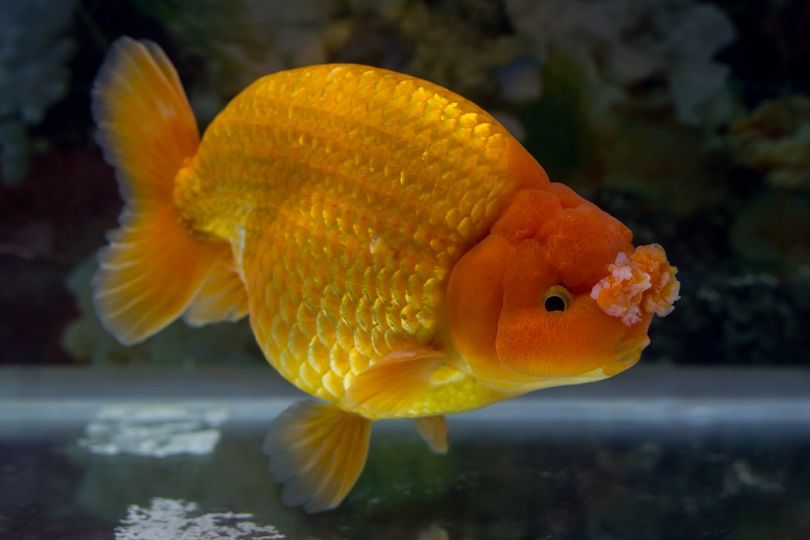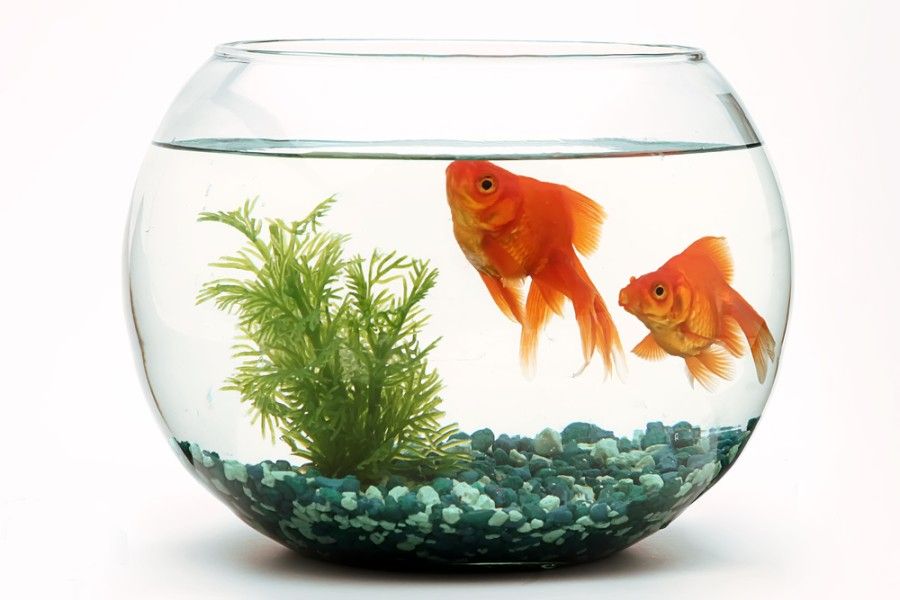Pearlscale Goldfish: Pictures, Size, Care, Tank Setup, & More
Updated on
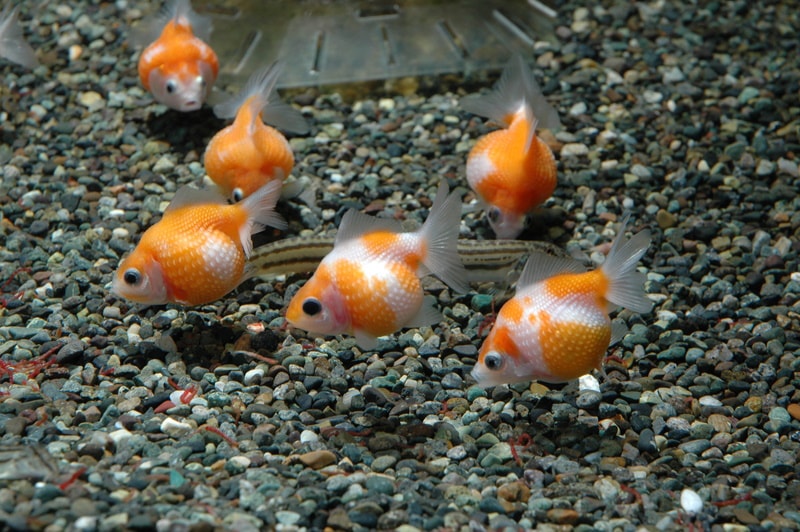
At first glance, you might mistake a Pearlscale for a goldfish with dropsy. Pearlscale Goldfish can be distinguished by their unusual appearance with protruding scales and abnormally rounded bellies. This has earned them the nickname “golf ball” or “ping-pong” goldfish. Aside from their whimsical appearance, the Pearlscale is one of the most peaceful and slow-moving varieties of goldfish.
| Size: | Up to 8 inches long |
| Lifespan: | 10–15 years |
| Similar Breeds: | Lionhead, Oranda, and Ryukin |
| Suitable for: | Experienced goldfish keepers |
| Temperament: | Peaceful and docile |
Pearlscale’s are a type of fancy goldfish that have been selectively bred to have their distinctive physical characteristics. They are equally social and peaceful fish that can be easy to care for if you have previous experience with fancy goldfish. However, their heavily modified bodies make them delicate fish that require specific housing and care requirements.
Before you decide to get a Pearlscale Goldfish, it is important to understand their care requirements since they are not the easiest goldfish variety to care for.
Pearlscale Goldfish Characteristics
How Much Do Pearlscale Goldfish Cost?
Pearlscale Goldfish are believed to have originated in China during the 20th century before being imported to Japan in the 1950s. Their interesting appearance is the result of genetic mutations and years of selective breeding.
Although they are not considered rare, they are not as common as some other goldfish varieties. You can find Pearlscale Goldfish in various pet stores, online retailers, and even from breeders.
Certain variations of the Pearlscale Goldfish can cost more because of their rarity, like the ones with a jelly-like growth on their heads known as a wen.
You can expect to pay around $10 to $50 for an average-looking Pearlscale Goldfish from a breeder or pet store. However, some larger Pearlscales with wen growth can cost as much as $100. Pearlscale Goldfish breeders may charge more since you pay for the quality of their stock.
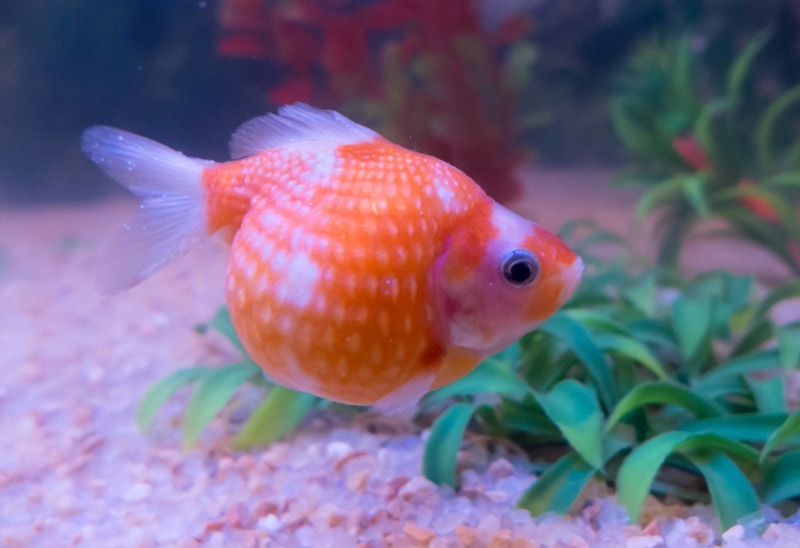
Sociability of the Pearlscale Goldfish
Do These Fish Make Good Pets?
Getting to own and care for a Pearlscale Goldfish is a rewarding experience. Although Pearlscale Goldfish can make good pets, they are not for everyone. Pearlscale Goldfish are delicate fish that need slight adjustments made to their living conditions, diets, and tank mates. Their anatomy is to blame for their more advanced care needs.
The Pearlscale’s round and compact belly makes them slow swimmers and more susceptible to swim bladder problems. These swim bladder problems can be tricky to correct, and sometimes Pearlscales cannot recover from them.
As a Pearlscale Goldfish owner, you will need to ensure that you can keep them with other slow-moving fancy goldfish in a spacious tank with little to no water current.
Does This Fish Make a Good Tank Mate?
Goldfish are social fish, and the Pearlscale is no exception. Pearlscale Goldfish benefit from having other goldfish in their aquarium, except for single-tailed goldfish. Other slow-moving fancy goldfish like the Oranda, Ranchu, Lionhead, and Ryukin goldfish are the most compatible tank mates for Pearlscale Goldfish.
Pearlscale Goldfish do not make good tankmates for single-tailed goldfish varieties. This is primarily due to their different anatomies and swimming abilities. The Pearlscale is a slow and overall poor swimmer. They take time to get around in a tank and even longer to find food. Single-tailed varieties like the comet goldfish are fast swimmers and will eat the food in the tank before the Pearlscale has a chance to.
Furthermore, single-tailed goldfish may bully, chase, and compete for resources with Pearlscale Goldfish, which is very stressful. It is best to stick to other fancy goldfish or large snails as Pearlscale tankmates, rather than other species of fish.
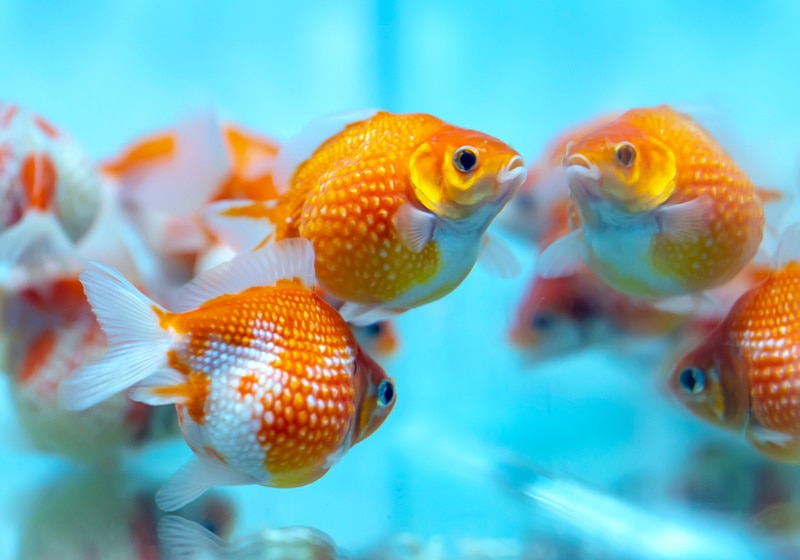
Care Guide & Tank Set Up
All Pearlscale Goldfish require a spacious and filtered fish tank. The tank should be no smaller than 20 gallons in size, with bigger being better for these goldfish. Unfortunately, Pearlscale Goldfish are not good additions to small bowls and vases.
Water Quality, pH, & Temperature
Pearlscale Goldfish are sensitive to sudden changes in their water quality. They do not tolerate traces of ammonia or nitrite in the water, so they should only be kept in fully cycled aquariums. Like all goldfish, the Pearlscale is a temperate or cold-water fish and does best at room temperature.
- Water Temperature: 65°–75° Fahrenheit (18°–24° Celsius)
- pH Range: 0–8.0
- Water Hardness: 80–160 ppm (parts per million)
- Ammonia: 0 ppm
- Nitrite: 0 ppm
- Nitrate: Below 20 ppm
You can test the level of ammonia, nitrite, and nitrate in the water using a liquid testing kit. There should be no traces of ammonia or nitrite in an aquarium, and water changes should be made to keep the nitrate level below 20 ppm.
Substrate
A substrate isn’t overly important for Pearlscale Goldfish, so some keepers don’t bother using a substrate in their Pearlscales aquarium. However, it is an option if you like the look of substrates in an aquarium. If you have live plants in your Pearlscales aquarium, a growth medium like aquatic soil will be necessary. Substrates like fine gravel and sand can be used in Pearlscale tanks.
Ideally, you want to avoid using pebbles or standard-sized gravel as they could be a choking hazard for goldfish.
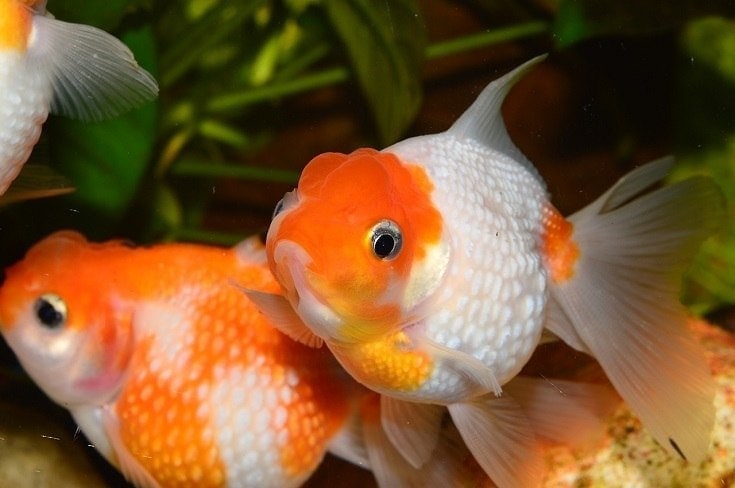
Plants
Live plants are an optional addition to your Pearlscale’s tank. They offer your Pearlscale Goldfish a more naturalistic environment and help improve water quality, so they do have their benefits in an aquarium. Any cold-water plants like anubias, elodea, and java fern are preferred for Pearlscale Goldfish. Some Pearlscale Goldfish may nibble at aquarium leaves, but they rarely consume the entire plant.
Lighting
Creating a day and night cycle is important for your Pearlscale Goldfish. They should never be kept in complete darkness both day and night nor should their light be on for more than 12 hours at a time. Pearlscale Goldfish prefer a low to moderate aquarium light during the day and a period of darkness at night.
If you grow live plants in the aquarium, an artificial lighting source is essential for the plant’s growth and health. Avoid keeping their aquarium brightly lit, since this may be stressful for your Pearlscale and could contribute to algae growth.
Filtration
Pearlscales produce a high waste bioload similar to other goldfish varieties. This means that they continuously eat and poop throughout the day, which can foul the water and contribute to poor water quality. A suitable filtration system is essential for your Pearlscale Goldfish. The filter has multiple functions in a Pearlscales aquarium since it prevents the water from becoming stagnant and polluted. Filters also host colonies of beneficial bacteria that play a vital role in the aquarium’s water quality.
Pearlscale Goldfish already have enough trouble swimming because of their unusual anatomy, so they should not have a current in their water. Their filter should produce a very low current, or ideally none at all. This makes sponge filters a great filtration system for the Pearlscale Goldfish.
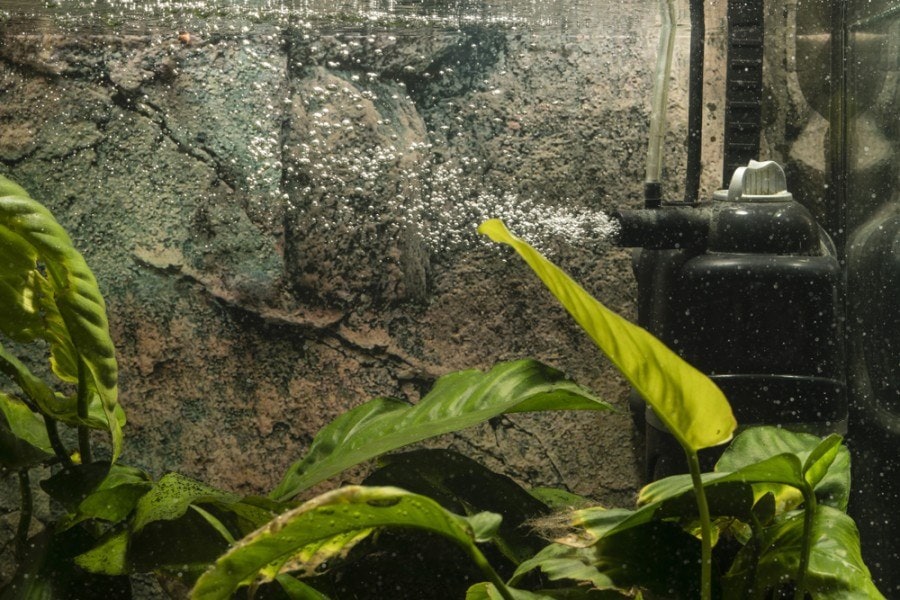
Things to Know When Owning a Pearlscale Goldfish:
Food & Diet Requirements
Pearlscale Goldfish are omnivores and benefit from a varied diet consisting of plant and animal-based foods. A Pearlscales staple diet can be flakes, pellets, or granules that have been formulated for goldfish. These foods are usually complete and balanced with all the necessary nutrients your goldfish needs.
Pearlscale Goldfish thrive on a varied diet, so you can include different treats and supplemental foods in addition to their main diet. Live or freeze-dried foods like baby brine shrimp, bloodworms, and tubifex worms offer your Pearlscale essential animal-based proteins. You do not have to offer additional protein sources often, but it is especially beneficial for young and growing Pearlscale Goldfish.
Furthermore, you can offer your Pearlscale Goldfish algae wafers, de-shelled peas, and blanched veggies for variety. Pearlscale Goldfish should be fed once or twice a day and as much food as they can consume within 3 to 5 minutes.
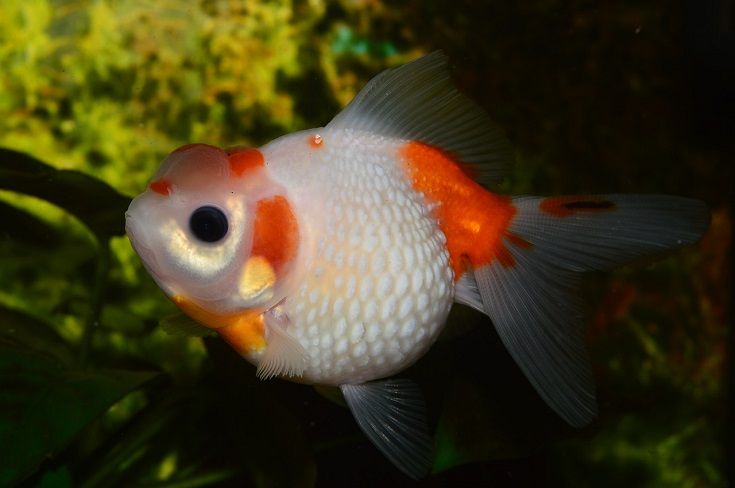
Size & Growth Rate
In comparison to other varieties of goldfish, the Pearlscale Goldfish isn’t very large. Most Pearlscale Goldfish reach an average adult size of 8 inches. However, they can reach 10 inches in size, but it is rare.
Pearlscale Goldfish do most of their growing within the first 2 years of their life. It can take up to 5 years for these goldfish to reach their full adult size. Their growth rate is usually dependent on their water quality, tank size, and diet. Pearlscales won’t grow very large when they are kept in unfavorable conditions like a small bowl or overstocked aquarium. They need a spacious tank, good water quality, and a balanced diet to develop properly.
Keep in mind that it can take 6 to 8 months for a Pearlscale to develop the domed scales they are named after. This is why young Pearlscales are sometimes mistaken for a very bloated fantail goldfish.
Varieties
The Pearlscale itself is a variety of fancy goldfish with a domed scale mutation. They have a single dorsal fin, pectoral fins, anal fins, and a paired tail. The Pearlscale’s most noticeable features are their enlarged bellies and visible scales.
They have nacreous scales, which are a combination of metallic and matt scales with reflective qualities. The Pearlscale’s domed and protruding scales are caused by calcium carbonate deposits that form on top of the scales. They have a shiny and pearl-like appearance, hence their name.
There are two variations seen in Pearlscale Goldfish—one where a fleshy bubble forms at the top of their head. They are called Crowned Pearlscales, and their inflated crown is very delicate and can easily be popped by sharp aquarium decorations. The second variation is when a fleshy hood (wen) grows on a Pearlscales head. This flesh growth increases in size as the fish ages and slows them down even more than their enlarged belly does.
Regardless of their varieties, Pearlscale Goldfish can be found in different colors and patterns. These colors include yellow, white, orange, brown, red, blue, and black. Some of the most popular color combinations seen in Pearlscale Goldfish are the calico and red-and-white coloration.
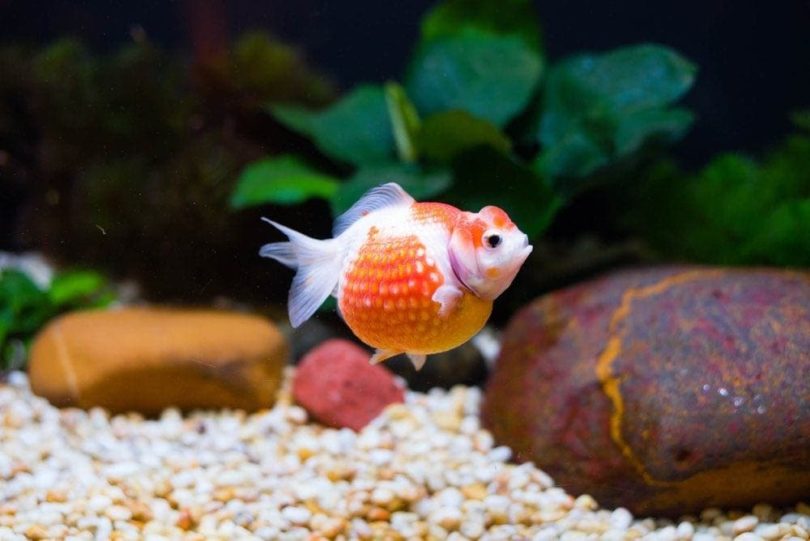
Lifespan and Health Conditions
With proper care, the average lifespan for a Pearlscale Goldfish is 10 to 15 years. Due to their delicate nature, it can be difficult to keep Pearlscale Goldfish alive long enough to see them age more than a decade.
The Pearlscale Goldfish has similar health conditions as other fancy goldfish. However, their compressed organs and abnormal anatomy make them highly susceptible to swim bladder problems. Their swim bladder organ is responsible for their buoyancy in the water. When this organ becomes compromised, it can affect how a Pearlscale Goldfish swims and stays afloat in the water.
- Scale abrasions
- Bloat
- Cataracts
- Swim Bladder Disorder
- Ammonia poisoning
- Dropsy
- Fin/tail rot
- Intestinal parasites
- Ich/white spot disease
- Epistylis
- Velvet
- Gill flukes
Male vs Female
| Male Pearlscale Goldfish: | Female Pearlscale Goldfish: |
| Longer and more pointed fins | More rounded fins |
| Slenderer | Rounder belly |
| White breeding tubercles on gills | Asymmetrical belly during spawning season |
| Concave vent | Convex vent |
| Chase females during breeding | Deposits eggs for spawning |
3 Little-Known Facts About Pearlscale Goldfish
1. The Pearlscale’s unusual visible scales are caused by calcium carbonate deposits that form as the goldfish ages.
2. Some Pearlscale Goldfish only develop their domed scales at 8 months of age.
3. The Pearlscale is one of the newest varieties of goldfish and new variations are still being developed.
Final Thoughts
If you are a more experienced goldfish keeper looking to add an unusual and peaceful variety of goldfish to your aquarium, the Pearlscale is a top choice. Although Pearlscales are more delicate than other fancy goldfish varieties, they can thrive with proper care. You can find Pearlscales in various color forms, with some being more common than others. When kept in a large, filtered, and well-maintained aquarium, Pearlscale Goldfish can thrive and live for more than a decade.
Featured Image Credit: Piqsels


